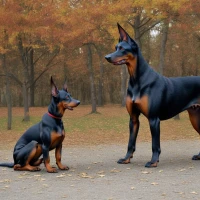German vs American Rottweiler: Key Differences With Pictures Revealed – Curious about which Rottweiler reigns supreme? Uncover the distinct traits, intriguing history, and striking visual contrasts between these two powerhouse breeds. Dive deep with our side-by-side comparison, featuring vibrant images that showcase their unique characteristics. Whether you’re a dog enthusiast, potential pet owner, or just love these majestic canines, our detailed exploration offers fascinating insights you won’t want to miss.
Visual Differences
German and American Rottweilers, while sharing a common lineage, exhibit distinctive characteristics that set them apart. The visual differences between these two breeds are apparent upon closer inspection. German Rottweilers tend to have a more robust and muscular build, reflecting their historical role as working dogs. Their bodies are compact, with a broader, more powerful chest and a slightly longer neck. They often have a thicker bone structure and a straighter back, giving them a commanding presence.
In contrast, American Rottweilers exhibit a leaner physique, with a more refined and elegant appearance. Their bodies are typically longer, and they have a more pronounced tuck-up, making them appear slimmer and faster. The head of the American Rottweiler is slightly narrower, and their muzzles can be longer, giving them a distinct profile.
These visual differences also extend to the coat and markings. German Rottweilers often have a denser coat with richer colorations, while American Rottweilers may display variations in their coat texture and shading. Both types have similar black and tan markings, but the distribution and intensity can vary.
Ultimately, recognizing these visual differences can help enthusiasts and potential owners better understand and appreciate the unique traits of each Rottweiler type.
At a Glance
At a glance, German and American Rottweilers may seem quite similar, but distinct differences set them apart. The German Rottweiler, bred following stringent standards set by Germany’s ADRK (Allgemeiner Deutscher Rottweiler-Klub), is typically more robust. It has a broader chest, thicker bones, and a blockier head. The emphasis in German breeding is on maintaining working abilities and adherence to exact breed specifications. Pictures of German Rottweilers reveal their formidable presence and powerful build, characteristics highly cherished in their heritage.
In contrast, the American Rottweiler has been bred with a slightly different focus. American breeders often prioritize conformance to the AKC (American Kennel Club) standards, which lean towards a more streamlined physique. American Rottweilers might appear taller and lighter, with a narrower head and a less pronounced chest compared to their German counterparts. This divergence in breeding goals is evident “at a glance” through various photographs.
Temperamentally, both breeds exhibit the loyal and protective nature for which Rottweilers are renowned. However, the German Rottweiler’s rigorous training and ancestry often make it more attuned to demanding tasks. Understanding these visual and temperamental nuances, at a glance, helps potential owners discern which type of Rottweiler aligns best with their expectations and lifestyle.
German Rottweiler Overview
The German Rottweiler and the American Rottweiler, while sharing common ancestry, exhibit distinct differences in their physical characteristics and temperaments. The German Rottweiler Overview reveals that German Rottweilers are traditionally bred under stringent standards set by the German Rottweiler Club (ADRK), ensuring a robust build and a stable, confident temperament. These dogs present a larger, more muscular frame with a wider head and thicker neck. Their tails are typically left natural, contributing to their imposing appearance.
American Rottweilers, on the other hand, have slightly varied breeding standards, often influenced by different kennel clubs. They tend to be leaner and more agile, with a narrower head and longer legs compared to their German counterparts. The practice of tail docking is more common among American breeders, partly due to historical breed standards.
When comparing temperaments, the German Rottweiler overview emphasizes their exceptional work ethic, often excelling in tasks that require strength and endurance. They are known for their calm demeanor and loyalty. While both breeds are incredibly loyal and protective, German Rottweilers are often considered more stoic and reserved, whereas American Rottweilers might display a somewhat more energetic and outgoing personality.
Understanding these differences through visual aids can significantly help potential owners in making an informed decision, ensuring they choose the right companion to match their lifestyle.
Personality
The German and American Rottweiler, while similar in appearance, exhibit distinct differences, especially concerning their personality. The German Rottweiler, bred following strict ADRK standards, is often recognized for its calm, confident, and composed demeanor. These dogs are known for their impeccable work ethic and loyalty, making them excellent service and working dogs. On the other hand, the American Rottweiler, primarily bred under AKC regulations, tends to exhibit a more diverse personality range. While they share the loyalty and protective nature of their German counterparts, American Rottweilers can sometimes be more energetic and playful.
These personality traits influence their suitability for different roles. For instance, the disciplined and focused personality of the German Rottweiler makes them ideal for tasks demanding high concentration and resilience. Conversely, the American Rottweiler’s more varied personality can be a better fit for family settings, where their playful energy is a delight.
Both types of Rottweilers are loyal and protective, but their varied personalities mean they might appeal to different kinds of owners. Those looking for a steadfast working companion might lean towards the German Rottweiler, while those seeking a playful family pet might prefer the American variant. Pictures vividly illustrate these nuances, capturing both the stoic German and the more vivacious American Rottweiler, underlining their unique personality traits.
Training
The German and American Rottweiler are often compared, but one of the distinguishing features between the two is their training needs and responses. German Rottweilers are generally bred with a focus on working abilities, making them highly responsive to rigorous training regimens. They are known for their strong work ethic and excel in obedience, tracking, and protection sports. This dedication to training makes them ideal for roles in law enforcement and search and rescue.
On the other hand, American Rottweilers, while still very trainable, often display a more laid-back temperament. They tend to be raised as family pets rather than working dogs, though they can certainly be trained for such roles. Their training might focus more on socialization and basic obedience to ensure they are well-mannered companions.
Both German and American Rottweilers benefit enormously from early, consistent training. Given their intelligent and sometimes stubborn nature, it’s crucial to establish boundaries and a solid training regimen from a young age. Positive reinforcement techniques are particularly effective for both types. Whether for work or companionship, proper training not only brings out the best qualities in these dogs but also ensures their well-being and safety.
Health & Care
German and American Rottweilers, while sharing a common lineage, possess distinct characteristics that set them apart. Both breeds are known for their loyalty, strength, and protective nature, but subtle differences in health & care can influence the best choice for prospective dog owners.
German Rottweilers typically have a stockier, more muscular build compared to their American counterparts. This robust physique, coupled with stringent breeding standards in Germany, often results in fewer genetic health issues. German breeders prioritize rigorous health & care protocols, ensuring each dog maintains optimal well-being.
On the other hand, American Rottweilers are bred more for versatility. They tend to be slightly leaner and taller, which can sometimes lead to different health considerations. American lines might face unique challenges such as hip dysplasia or heart issues, necessitating vigilant health & care routines from their owners, including regular vet check-ups and tailored diet plans.
Both types require substantial exercise, mental stimulation, and socialization, but their distinct physical attributes and health profiles mean tailored approaches are crucial. Understanding these key differences, supported by visual comparisons, can guide prospective Rottweiler owners in providing the best health & care for their chosen companion. Whether opting for a German or American Rottweiler, informed care ensures a long, healthy, and happy life for these remarkable dogs.
Breeding
When comparing the German Rottweiler to the American Rottweiler, specific breeding characteristics highlight key differences between the two. German Rottweilers are bred primarily in Germany under stringent guidelines set by the Allgemeiner Deutscher Rottweiler Klub (ADRK). This ensures that only dogs with desirable traits, such as strong physical conformation and stable temperaments, contribute to the gene pool. As a result, German Rottweilers often exhibit a robust build, a blockier head, and a more defined chest.
In contrast, American Rottweilers are bred with a broader level of variability due to the less rigid guidelines in the United States. The American Kennel Club (AKC) does have standards, but they allow for more flexibility, leading to a wider range of appearances and temperaments. American Rottweilers might appear leggier, with a leaner physique compared to their German counterparts.
The differences in breeding practices between the two regions can also affect the dogs’ health and behavior. German Rottweilers are often deemed more consistent in their traits, while American Rottweilers might show more diversity. Pictures of these dogs reveal the visual contrasts, emphasizing how breeding standards impact both appearance and characteristics.
Suitable For:
The German and American Rottweilers, while stemming from the same lineage, exhibit distinct characteristics that set them apart. When choosing which type might be more suitable for your lifestyle, understanding these differences is crucial.
Firstly, the German Rottweiler is often larger and more robust, bred under stringent guidelines ensuring adherence to specific standards. Their heads are broader, their chests are deep, and they exude a more powerful presence. These dogs are typically bred for work, making them highly suitable for families seeking a protective and loyal companion.
In contrast, the American Rottweiler, while still formidable, is generally more streamlined and less bulky. American breeders often prioritize agility and versatility, resulting in a slightly different build. This makes them more suitable for roles that require more endurance and flexibility, such as obedience and agility sports.
Both breeds share essential traits such as intelligence, loyalty, and strength, but their subtle physical and temperamental differences can greatly influence your decision.
Careful consideration of these distinctions will ensure that you select the Rottweiler most suitable for your needs, keeping in mind factors like activity level, space, and purpose. Their unique attributes are beautifully illustrated in side-by-side comparisons, which further highlight the unique appeal each type of Rottweiler holds.
American Rottweiler Overview
When comparing the German vs American Rottweiler: Key Differences With Pictures Revealed, it’s essential to understand the distinctive traits that set these two breeds apart. The American Rottweiler Overview is crucial for grasping the nuances of this breed. American Rottweilers typically have a sleeker build compared to their German counterparts, exhibiting a more refined and agile appearance. They may also have docked tails, which is customary in the United States, whereas German Rottweilers often retain their natural tails due to different breeding standards.
American Rottweilers are often bred with an emphasis on versatility and athleticism, making them excellent working dogs, as well as outstanding family companions. In terms of temperament, they are known for their protective instincts, loyalty, and intelligence. Visual differences are also noticeable; American Rottweilers tend to have a slightly narrower head and leaner musculoskeletal structure.
Understanding these differences through a detailed American Rottweiler overview helps potential owners make an informed decision. It also provides insight into the breed’s suitability for various roles, whether it’s for protection, work, or companionship. This comprehensive comparison, bolstered with pictures, sheds light on the unique qualities of both American and German Rottweilers, enriching the knowledge of enthusiasts and prospective owners alike.
Personality
When comparing the German and American Rottweiler, personality traits stand out as defining characteristics. German Rottweilers are known for their calm and confident demeanor, often displaying a reserved and thoughtful nature. These dogs are meticulously bred in Germany with strict guidelines that emphasize temperament and usability in working roles. Consequently, they tend to exhibit an even temperament, making them excellent guard dogs and loyal family companions.
In contrast, the American Rottweiler’s personality can be somewhat more varied due to different breeding standards in the United States. American Rottweilers may display a wider range of behaviors, from outgoing and sociable to protective and wary, depending on their lineage and upbringing. Despite these variances, the core traits of loyalty, bravery, and intelligence remain strong in both types.
Both German and American Rottweilers require proper socialization and training to harness their full potential. Their personalities make them suitable for various roles, from family pets to working dogs in law enforcement or search and rescue. High-quality images of both types underscore their physical and behavioral distinctions, offering a visual complement to their contrasting temperaments.
In summary, while both German and American Rottweilers share many foundational traits, distinctive differences in personality are evident due to their breeding histories. These unique characteristics make each type special in its own right.
Training
When it comes to comparing German and American Rottweilers, understanding their distinct characteristics is crucial, especially in terms of training. Both breeds have their own unique features and temperament, shaped by their lineage and breeding practices. German Rottweilers are bred under strict guidelines that emphasize physical structure and working ability. They tend to be slightly larger, with a robust, muscular build and a blockier head. This breed’s lineage prioritizes stability, making them particularly reliable in roles such as security and search and rescue.
American Rottweilers, on the other hand, have a more varied appearance due to less stringent breeding standards. They might be slightly leaner and have a more refined head shape. Importantly, training plays a pivotal role in managing both types of Rottweilers. German Rottweilers often exhibit a higher drive and stamina, necessitating a training regimen that incorporates frequent mental and physical engagement. American Rottweilers may adapt better to family environments but still require firm and consistent training to channel their innate protective instincts effectively.
Pictures showcasing these differences can be incredibly enlightening, highlighting the variance in silhouette, head shape, and overall demeanor. Consistent training tailored to the specific traits of German and American Rottweilers ensures that both breeds can excel as loyal, well-behaved companions or working dogs.
Health & Care
German Rottweilers and American Rottweilers may look similar at first glance, but there are key differences between the two varieties that are important for potential owners to consider, especially regarding Health & Care. German Rottweilers are bred following stringent guidelines set by the Allgemeiner Deutscher Rottweiler-Klub (ADRK). This results in dogs with robust build and fewer health issues, thanks to rigorous testing and breeding standards. The emphasis on Health & Care is evident in the German variety, which generally exhibits a longer lifespan.
On the other hand, American Rottweilers are bred under less stringent guidelines, often focusing more on appearance than health. This can sometimes result in a more varied physical appearance and a higher likelihood of health problems such as hip dysplasia and heart conditions. Due to these factors, Health & Care management for American Rottweilers needs to be particularly attentive, including regular vet visits and a proper diet.
Both German and American Rottweilers require substantial exercise and mental stimulation to maintain optimal Health & Care. Understanding these key differences is vital for prospective owners to ensure they choose a Rottweiler that fits their lifestyle and is likely to enjoy a long, healthy life.
Breeding
The German and American Rottweilers, though sharing a common lineage, exhibit distinct characteristics due to variations in breeding practices. One of the most noticeable differences lies in their physical appearance. German Rottweilers generally have a more robust and muscular build, often attributed to strict breeding guidelines upheld by the Allgemeiner Deutscher Rottweiler-Klub (ADRK). In contrast, American Rottweilers may appear slightly leaner and taller, a result of the more flexible breeding standards in the United States.
Temperament is another area where these two breeds diverge due to breeding influences. German Rottweilers tend to be more calm and composed, thanks to selective breeding focused on preserving their working dog traits. They are often prized for their loyalty and protective instincts. American Rottweilers, on the other hand, might exhibit a more varied temperament, ranging from highly energetic to relaxed, reflecting the broader spectrum of breeding objectives practiced by American breeders.
Additionally, differences in health can be traced back to breeding priorities. The stringent criteria for breeding in Germany often result in dogs with fewer genetic issues, whereas American Rottweilers might face a higher incidence of hereditary health problems due to less rigorous breeding controls. Through these distinctions, it’s clear that breeding practices significantly impact the unique traits seen in German vs American Rottweilers.
Suitable For:
The German and American Rottweilers, while sharing common ancestry, exhibit notable differences in their physical attributes and temperament, which make each suitable for different roles and environments. The German Rottweiler is typically more robust and heavier, boasting a thicker neck and broader chest, adhering strictly to the breeding standards of the Allgemeiner Deutscher Rottweiler-Klub (ADRK). This breed tends to have a calm, confident demeanor, making them suitable for families, therapy work, and as search and rescue dogs.
In contrast, the American Rottweiler, influenced by the American Kennel Club (AKC) standards, is slightly leaner with a more streamlined physique. These dogs are known for their high energy and sharp instincts, making them particularly suitable for roles in law enforcement, agility competitions, and active households. Their alert and protective nature renders them excellent guard dogs.
Photographic comparisons highlight these distinctions clearly, showing the German Rottweiler’s muscular build versus the American Rottweiler’s athletic structure. Understanding these differences is crucial for prospective owners when deciding which breed is suitable for their specific needs and lifestyle. Both breeds, with their unique characteristics, can offer loyal and intelligent companionship, provided they are matched with the appropriate environment and activities.
Other Notable Differences Between the German and American Rottweilers
The German and American Rottweiler may appear similar at first glance, but distinct differences set them apart. One of the primary factors involves breed standards: the German Rottweiler adheres strictly to guidelines set by the Allgemeiner Deutscher Rottweiler Klub (ADRK), while the American counterpart follows standards by the American Kennel Club (AKC). The German Rottweiler is typically more robust with a bulkier frame, larger head, and a thicker neck.
Other notable differences between the German and American Rottweilers include temperament and training adaptability. The German Rottweiler is often perceived as calmer and well-rounded, likely due to rigorous breeding practices that emphasize stable behavior and working aptitude. On the other hand, American Rottweilers, bred more for appearance, may exhibit a higher energy level and require a different training approach.
Another significant aspect lies in their tails. German Rottweilers frequently have natural, un-docked tails as per ADRK regulations, while tail docking is more common in the American breed, aligning with AKC preferences. Coat and coloration are largely consistent, but slight variations exist in the markings and texture.
In summary, the German and American Rottweilers, while sharing a common heritage, diverge markedly in physical attributes, temperament, and breeding standards. These distinctions are crucial for potential owners to consider when choosing their ideal canine companion.
Gait/Movement
When comparing the German and American Rottweiler, one significant aspect to consider is their gait. Originating from two different breeding philosophies, these variations exhibit distinguishing characteristics not just in physical attributes but also in their movement. German Rottweilers are bred in adherence to strict standards set by the Allgemeiner Deutscher Rottweiler-Klub (ADRK). As a result, their gait tends to be more robust and powerful, effortlessly covering the ground with each stride. This strength and fluidity highlight their purpose as working dogs, capable of navigating diverse terrains.
In contrast, American Rottweilers, shaped by more lenient breeding regulations, display a gait that, while still strong, may not possess the same level of consistency. Their movement often appears less fluid and can vary significantly from one dog to another. Observing them in motion, one can notice subtle differences in their stride length and overall coordination.
Understanding these distinctions in gait aids in appreciating the broader spectrum of the Rottweiler breed. Pictures further emphasize these contrasts, showcasing how breeding standards have influenced their agility, power, and elegance in motion. Whether you prefer the traditional robustness of the German Rottweiler or the varied characteristics of the American counterpart, both exhibit a unique and captivating presence in their movement.
Working Skills
The German and American Rottweilers may appear similar at first glance, but there are key differences that set them apart, particularly in their working skills. The German Rottweiler, bred with a strict adherence to the breed standard, is renowned for its robust build and superior working skills. These dogs are often employed in roles that demand high endurance and strength, such as search and rescue missions or police work. Their physical prowess is complemented by their keen intelligence and strong work ethic.
In contrast, the American Rottweiler is more commonly bred for companionship and show. While they can certainly exhibit excellent working capabilities, the emphasis on aesthetic standards means they might not always measure up to the rigorous working abilities seen in their German counterparts. American Rottweilers tend to be slightly leaner and often have a less intense demeanor, making them well-suited for family settings.
Visual distinctions include the German Rottweiler’s broader head and thicker build, compared to the American Rottweiler’s more refined features. However, regardless of lineage, both types possess inherent qualities such as loyalty, protectiveness, and intelligence. With the right training, either can excel in roles that require advanced working skills.
Kennel Club Breeding Regulation
The German vs American Rottweiler debate often stirs passionate discussions among enthusiasts, primarily due to the distinctions in appearance, temperament, and breeding standards. A pivotal factor in understanding these differences lies in the Kennel Club Breeding Regulation adhered to in each country.
The German Rottweiler is bred under stringent guidelines established by the Allgemeiner Deutscher Rottweiler Klub (ADRK). These regulations emphasize maintaining the breed’s working capabilities. As a result, German Rottweilers typically exhibit a more robust physique, a thicker bone structure, and a blockier head. Their breeding also focuses on temperament, ensuring that these dogs are stable, confident, and possess strong working instincts.
Conversely, American Rottweilers are often bred under the American Kennel Club (AKC) standards, which provide more leniency. This flexibility can lead to a variation in size, head shape, and overall build. American Rottweilers might appear lighter and leaner compared to their German counterparts. The AKC’s approach also allows breeders to accentuate specific physical traits, occasionally at the expense of working ability.
Both types maintain the breed’s loyalty and protective nature, yet the differences rooted in their respective Kennel Club Breeding Regulations are significant. Understanding these distinctions can help potential owners choose the type that best fits their needs and preferences. Familiarizing oneself with these regulations, along with visual comparisons, offers invaluable insights into selecting the ideal Rottweiler.
Price
German and American Rottweilers, though similar in many aspects, exhibit key differences that can influence your decision-making process, especially when considering the price. German Rottweilers are bred under strict standards enforced by the ADRK (Allgemeiner Deutscher Rottweiler-Klub), ensuring adherence to breed characteristics like temperament and physical traits. This meticulous breeding process often results in a higher price.
Conversely, American Rottweilers are bred under guidelines by the AKC (American Kennel Club), which are less stringent. This can lead to variability in the offspring’s appearance and behavior, generally making American Rottweilers more affordable compared to their German counterparts. The price distinction between the two can be considerable, reflecting the breeding practices and the stringent evaluation which German Rottweilers undergo.
Physical differences also play a role. German Rottweilers are typically more robust with a larger, more defined head, whereas American Rottweilers can display a leaner physique. Additionally, pictures reveal German varieties have a distinct tail docking policy, differing from the American practices.
Though temperamentally similar, the price disparity underscores the controlled breeding environment in Germany, setting apart German Rottweilers in terms of quality. Ultimately, weighing these factors with an eye on the price will guide potential owners in making an informed choice between the two prestigious breeds.
Which Breed Is Right for You?
When choosing a Rottweiler, understanding the differences between the German and American Rottweiler breeds is essential in determining which breed is right for you. German Rottweilers are typically bred to stricter standards and are known for their robust, muscular builds. They often have docked tails and larger, more defined heads, giving them a powerful and intimidating presence. Pictures of German Rottweilers reveal their deep chest and broad shoulders, hallmark traits that make them formidable working dogs.
American Rottweilers, on the other hand, are often bred for versatility, balancing both working and show qualities. They may appear slightly less robust compared to their German counterparts, with softer physical traits and more variation in tail docking. Photos of American Rottweilers often show a more refined and proportionate physique, suitable for diverse roles ranging from family pets to service animals.
To decide which breed is right for you, consider your lifestyle and needs. If you desire a dog with stringent breed standards and a more pronounced working capability, the German Rottweiler may suit you best. Meanwhile, the American Rottweiler offers a balance of work and companionship, adapting well to various roles and living situations. Both breeds share loyalty and intelligence, ensuring a devoted and loving companion.










